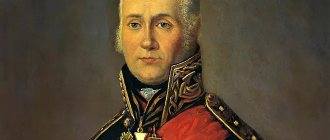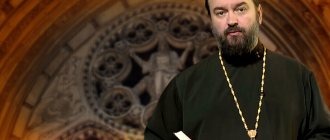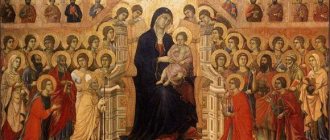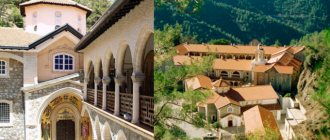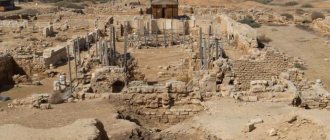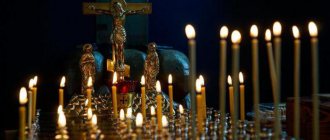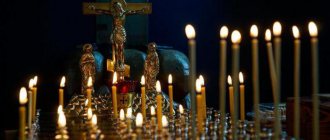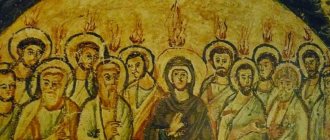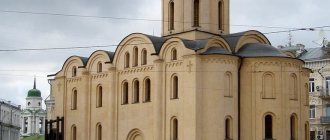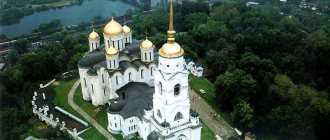When the admiral was canonized in the 2000s, forensic examinations of his remains were carried out, during which it was established that in childhood he suffered partial aseptic necrosis of the head of the right femur. The consequences of such a serious illness in the form of an ingrained habit of squeezing his sore leg stayed with him for the rest of his life. Contemporaries recall that when Ushakov was worried or had to make a serious decision, he always “stood on one leg.”
The same studies clearly established that Ushakov hardly possessed the outstanding physical strength necessary for a bear hunter, since he had a slender (some researchers indicate a graceful) physique, short (up to 168 cm) height, with narrow (about 39 cm) shoulders, narrow hands and feet.
Childhood
Childhood and adolescence:
- Where are you from?
Ushakov was born in the Rybinsk district of the Yaroslavl region.
- Origin of the surname.
The surname Ushakov comes from the nickname of one of Fyodor Fedorovich’s distant relatives “Ushak”.
- Parents.
Fyodor Ushakov was born into an impoverished noble family. His father served in the Preobrazhensky Regiment, but he failed to achieve success, so he retired with the rank of sergeant, and his mother raised the children. It was his mother who instilled in Fyodor Fedorovich the love of God and developed high morality.
- Studies.
Ushakov studied at the Naval Cadet Corps, where he showed excellent results. So, from childhood he was prepared for military service.
Retired
Unfortunately, all the services of the famous admiral to Russia were forgotten as soon as he resigned and left the capital. Even the Navy Department did not remember him. But it was Ushakov who invested the most effort in the creation and development of a combat-ready Black Sea Fleet.
Admiral F.F. Ushakov ended his life in October 1817 on his estate. He was buried in a monastery near Temnikov. By the end of the century, the modest grave was almost invisible.
In the last years of his life, the great naval commander led a modest and secluded life in the village of Alekseevka, and was engaged in charity work. He didn't like to draw attention to himself. And this, coupled with the efforts of enemies, became the reason that the name F.F. Ushakov was practically forgotten.
Only in 1983 did a battleship appear in the Russian fleet, named after Admiral Ushakov.
Fleet
Military service:
- First duty station.
The Baltic Fleet became the first place of Ushakov's long and brilliant service.
- First command.
For the first time, Fedor Fedorovich commanded a ship when he was only 25 years old. Although the ship was small, the future admiral did an excellent job.
- Receiving titles.
Ushakov moved up the career ladder very quickly. Literally 10 years after graduating from the Naval Cadet Corps, he received the rank of captain of the first rank, and 8 years later he became an admiral.
- First battle.
In the very first battle, in which Ushakov acted as commander, he completely defeated the most powerful fleet of the Ottoman Empire. In the future, he would deal crushing blows to the Turks 3 more times.
- Peace between Russia and the Ottoman Empire.
It is believed that it was thanks to the successes of Fedor Fedorovich that a peace treaty was signed between the Russian and Ottoman Empires.
War in the Mediterranean
Even more impressive victories were won by Fedor Fedorovich Ushakov in the Mediterranean Sea during the war with France. The Russian squadron liberated the Greek Ionian Islands, adhering to the tactics of shelling coastal fortifications and subsequent landings. In 1798, the island of Corfu, which was considered impregnable, was finally recaptured from the French. These battles can be considered the starting point for the birth of the Russian amphibious assault.
The Russian victory at Corfu was so brilliant that it made the legendary Suvorov regret that he did not participate in this battle!
After liberation, the first independent Greek state was created in the Ionian Islands - the Republic of the Seven Islands. Ushakov also took an active part in its political arrangement. The admiral drew up the Constitution of the new state and achieved the conclusion of an agreement beneficial to both Russia and the Greek government.
Off the Italian coast captured by the French, the Russian squadron again won impressive victories. After failing to hold Naples, the coastal fortresses were surrendered by the French command in order to avoid large casualties.
In 1800, Ushakov's squadron returned to Sevastopol in triumph.
Success
Successes and differences:
- Rescue supplies.
When Ushakov was 27 years old, he distinguished himself while rescuing valuable supplies from sinking ships. Such a brave act did not go unnoticed.
2. Absence of lesions.
Throughout his long and valiant service, Ushakov did not suffer a single defeat. It is worth saying that he participated in 43 naval battles. All battles ended in success for the Russian fleet.
- Development of new tactics.
The admiral devoted 6 years of his life to developing new tactics for managing the Russian fleet.
Ushakov during the Russian-Turkish War
Ushakov's naval skills were first noticed and appreciated during the Russian-Turkish War. He was not afraid to break the already existing traditions of naval combat. Previously, ships moved only parallel to each other and fired at the enemy from the side. But Ushakov did not adhere to these orders; he preferred to disrupt the formation of enemy ships and make the flagship the main target. Having disabled him, Ushakov sowed panic among the enemy, who was left without command. As a result, the scattered ships, unable to maintain battle order, were destroyed.
Like everything new, this naval combat tactic also met with strong resistance from the fleet command. But Ushakov’s brilliant victories convinced even the most stubborn opponents of the correctness of his actions. This played a significant role in his appointment as squadron commander.
Awards
Awards and achievements:
- Saint.
At the beginning of the twenty-first century (in 2001), the Russian Orthodox Church canonized Ushakov as a righteous warrior.
- National hero.
On the island of Corfu, the Russian admiral is considered a national hero. The reason for this was that it was Ushakov who liberated the island of Corfu from French occupation. By the way, for this he received the rank of admiral.
- Fighting the plague.
The first award of the famous military figure was the Order of St. Vladimir, which he received for his courage during the fight against the plague epidemic in Kherson.
- Empress Catherine the Second.
Prince Potemkin, one of Catherine the Second's favorites, spoke very highly of young Ushakov. He saw potential in him, so he often told the empress about Ushakov. One day, Catherine the Second decided to personally meet the admiral and invited him to St. Petersburg. Then Fedor Fedorovich was awarded a cross with the relics of saints, and also received the rank of vice admiral.
- Memory.
Many streets, squares, avenues are named in honor of Ushakov, many monuments have been erected to him, and not only in Russia.
- Awards.
In total, during his entire service he received 12 prestigious orders.
Interesting facts about Fedor Ushakov
In the history of the Russian Black Sea Fleet, full of bright victories, Admiral Fedor Ushakov occupies an honorable place. This brilliant naval commander showed himself at his best, and he was not only a talented tactician and strategist, but also a subtle diplomat. Using the trust of the throne, Fyodor Ushakov more than once made important state decisions on his own responsibility, and, as subsequent events showed, he never made any serious mistakes.
Facts from the biography of Fedor Ushakov
- The Ushakov family belonged to the poor small nobility.
- Of the seven children of his parents, Fedor was born the fourth.
- From childhood he was prepared for naval service, so the future admiral studied in the Naval Cadet Corps. He showed brilliant results, losing only to three other cadets at the end of the training.
- Fyodor Ushakov’s first place of service was the Baltic Fleet (interesting facts about the Baltic Sea).
- For the first time, he was entrusted with commanding his own ship, albeit a small one, at the age of 25.
- At the age of 27, Fyodor Ushakov distinguished himself while rescuing valuable supplies from sinking ships on the Don River, which also did not go unnoticed.
- Less than 10 years passed between his graduation from the Cadet Corps and receiving the rank of captain of the first rank - the result is simply excellent. And even less time passed between the ranks of captain of the first rank and admiral - 8 years.
- Fyodor Ushakov's father served in the Preobrazhensky Regiment almost all his life, but did not achieve significant success in the service, and retired with the rank of sergeant.
- His surname came from the nickname “Ushak”, by which one of his ancestors was known.
- One of the patrons of the then young, but already quite famous and promising captain Ushakov was Prince Potemkin, the favorite of Empress Catherine II (interesting facts about Catherine II).
- The admiral did not drink alcohol, and in general looked askance at those who abused it. At the same time, he punished not the guilty sailors for drunkenness, but their commanders.
- In the very first battle in which he took part as fleet commander, Fyodor Ushakov completely defeated the fleet of the Ottoman Empire. Subsequently, he inflicted crushing defeats on the Turks three more times.
- Ushakov managed to visit the waters of all the seas of Europe, without exception.
- It was thanks to the military successes of Fedor Fedorovich that peace was eventually signed between Russia and the Ottoman Empire.
- In 2001, the Russian Orthodox Church canonized Fyodor Ushakov as a righteous warrior.
- Unfortunately, not a single lifetime portrait of Fyodor Ushakov has survived to this day.
- Just as Suvorov did not lose a single battle on land, so Ushakov did not lose a single battle at sea. In total, he took part in 43 battles, and won all of them (interesting facts about Suvorov).
- Throughout his life, Ushakov was an extremely straightforward person. This more than once created problems for him when communicating with various court officials who were not accustomed to such behavior.
- He also developed new fleet management tactics. He worked on it for 6 whole years.
- How much the admiral cared for the fleet entrusted to him is evidenced by the fact that he more than once paid for ship repairs from his own pocket when government funding was delayed due to bureaucracy and other problems.
- On the island of Corfu, which belongs to Greece, to this day Fyodor Ushakov is a national hero. It was he who liberated Corfu from French occupation, for which, by the way, he eventually received the rank of admiral.
- Ushakov, in addition to his service, devoted his mature years to charity. He spent a fair share of all the money he had on helping those less fortunate.
- His first award was the Order of St. Vladimir, which he received not for military affairs, but for his help in the fight against the plague epidemic that broke out in Kherson.
- In total, Fyodor Ushakov received 12 orders and other comparable awards.
- The name of the great naval commander was or still is on numerous streets and sea vessels. There are also many monuments to him, and not only in Russia.
- Interesting facts about Chaliapin
- Interesting facts about Paul I
- Interesting facts about Corfu
- Interesting facts about Rimsky-Korsakov
- Interesting facts about Mordovia
- Interesting facts about Kutuzov
- Interesting facts about Peter I
- Interesting facts about Copernicus
The peaceful life of Fyodor Ushakov
As soon as Russia was repulsed from Turkish and European threats, the role of naval commanders in the fate of the fatherland, apparently, began to seem less significant to the rulers. Admiral Ushakov did not escape the fate of oblivion. First, he was appointed commander of the Baltic Rowing Fleet, then head of the naval teams in St. Petersburg. In 1807, Ushakov wrote a resignation letter to the emperor.
“... in my old age, I am burdened with mental and physical illness and I am afraid, given the weakness of my health, that my service will be a burden, and therefore I most humbly ask that by your highest Imperial Majesty’s decree it be ordered that I be dismissed from service due to my illness.” The emperor granted the request, and Ushakov retired “... due to illness, from service with his uniform and the required salary.” The admiral was then 62 years old.
Ushakov moved to the quiet village of Alekseevka, Temnikovsky district, Tambov province, which he acquired back in 1805. Nearby was the Sanaksarsky monastery, where almost half a century ago, in 1764, the rector was Fyodor Ushakov’s uncle, John, in monasticism Theodore.
In 1812, when the French came to Russia with the war, at the provincial meeting of the nobility Admiral Ushakov was elected head of the internal Tambov militia, but the admiral no longer felt strong and refused the offered position.
Victory over the epidemic
Plague and smallpox in the 18th century were considered the most terrible diseases. Epidemics caused enormous damage to the population, people died in entire cities and villages. Epidemics caused real panic.
Anxiety also gripped Kherson. The epidemic intensified, the construction of ships, despite extreme military necessity, was stopped, and the crews were taken to the steppe.
Since there were not enough doctors, the responsibility for maintaining the health of the ship's crews was assigned to the commanders. Ushakov introduced a strict quarantine regime: the team (almost 500 people) was divided into artels, each of which was placed in a separate tent made of reeds, and communication was strictly prohibited.
The image of the admiral in culture and art
His image attracted many representatives of the creative intelligentsia:
- artists I. Pavlinov, A. Blinov and V. Ilyukhin;
- Midshipman A. Decalde;
- sculptors N. Dadynin, P. Kravchenko and A. Chubin;
- writer A. Stein;
- director M. Romm;
- icon painter S. Mishchenko.
